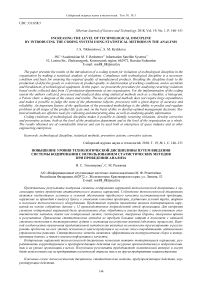Increasing the level of technological discipline by introducing the coding system using statistical methods in the analysis
Автор: Tikhomirova I.S., Ryzhkova S.M.
Журнал: Сибирский аэрокосмический журнал @vestnik-sibsau
Рубрика: Технологические процессы и материалы
Статья в выпуске: 1 т.19, 2018 года.
Бесплатный доступ
The paper presents the results of the introduction of a coding system for violations of technological discipline in the organization by making a statistical analysis of violations. Compliance with technological discipline is a necessary condition and basis for ensuring the required quality of manufactured products. Breaking the discipline leads to the production of defective goods, to a decrease in product quality, to deterioration of working conditions, and to accidents and breakdowns of technological equipment. In this paper, we present the procedure for analyzing recurring violations based on the collected data from 12 production departments of one organization. For the implementation of the coding system the authors collected, processed and analyzed data using statistical methods such as a checklist, a histogram, a Pareto chart, a diagram of the causes and results. The use of statistical methods does not require large expenditures and makes it possible to judge the state of the phenomena (objects, processes) with a given degree of accuracy and reliability. An important feature of the application of the presented methodology is the ability to predict and regulate problems at all stages of the product life cycle and, on the basis of this, to develop optimal management decisions. Sta- tistical methods are effective tools for collecting and interpreting data, as well as analyzing quality information. Coding violations of technological discipline makes it possible to identify recurring violations, develop corrective and preventive actions, both at the level of the production department and at the level of the organization as a whole. The results obtained are of considerable interest and can be used both at enterprises of space industry and at other engineering enterprises.
Technological discipline, statistical methods, preventive actions, corrective actions
Короткий адрес: https://sciup.org/148177791
IDR: 148177791 | УДК: 331:658.5
Текст научной статьи Increasing the level of technological discipline by introducing the coding system using statistical methods in the analysis
Introduction. According to the analysis made by “Roskosmos” State Corporation the existing level of technological discipline at the enterprises of the rocket and space industry in 2015–2016 does not ensure the solution of the tasks assigned to “Roskosmos” State Corporation to reduce the accident rate.
In order to ensure the required level of technological discipline in the creation of spacecraft, the JSC “ISS” named after academician M. F. Reshetnev decided to introduce a coding system for violations of technological discipline.
The purpose of the implementation of the system is the development of preventive actions to prevent recurring violations of technological discipline at the organization level.
Implementation objectives:
– detection of recurring violations in all production units of the organization;
– analysis of recurring violations;
– development of measures to prevent violations and improve the technological processes, both at the level of structural departments and at the level of the organization as a whole.
Introducing the coding system. The first stage of the introducing the system was the detection of all violations of technological discipline through the analysis of acts of external and internal checks on technological discipline, monthly and annual reports on the quality of production departments [1; 2].
The second stage is the identification of recurring violations of technological discipline.
The third stage is the analysis of the objects of control where recurring violations were revealed. On the basis of results of the analysis, the following control objects were identified [1]:
– manufacturing process;
-
– materials, component parts, electrical goods, semifinished products, blanks;
-
– details and assembly units, kits, products;
-
– performers of the technological process;
-
– design documentation (hereinafter referred to as “DD”) and technological documentation (hereinafter – TD);
-
– equipment; jigs, fixtures and tools (hereinafter – JFT) for monitoring and testing;
-
– workplace;
-
– circulation of products.
The fourth stage is the division of recurring violations among the objects of control.
The fifth stage is the coding of recurring violations. All objects of control are numbered from 1 to 9.
In each object recurring violations are encoded. Tab. 1 shows an example of coding violations at the control object 4 “Performers of the Technological Process”.
In each object it was accepted to enter the code – “Others”, in case the detected violation does not fit into any code.
The sixth stage is the introduction of the coding system into the organization quality management system by re-publishing the organization standard for control of technological discipline.
After the introduction the system was tested in all production departments. Each inspection of technological discipline is recorded in the journals or in the acts of inspections; in case of a violation a violation code is inserted in a special column [3]. Each production department carries out a monthly analysis of technological discipline (the number of audited control objects according to types of inspections, the number of violations detected, the violation code). All information is transferred to the quality control department of the organization (hereinafter – QCD) for analysis throughout the organization [3–6]. Processing the data on violations of technological discipline is shown in fig. 1.
Once in every six months all production departments make quality analysis with the release of the report which has a section on the analysis of technological discipline. Measures are being developed on the basis of the analysis results to prevent recurring violations [7–9].
The results of the analysis of technological discipline in production departments, the data are transferred to the QCD for analysis at the level of the organization as a whole. According to the results of the quality reports analysis for the first half of 2017 the QCD analyzed the violations of the technological discipline throughout the organization. Fig. 2 presents recurring violations of technological discipline in the organization for the first half of 2017 in the form of a histogram (a special type of a bar graph that allows one to visualize the distribution of statistical data) [10–14].
The results of the analysis for the first half of 2017: the organization checked 6348 objects, revealed 1102 violations (17 %); recurring violations are the following:
-
– certification of JFT, equipment, control and testing has expired (9 %);
-
– general comments on DD and TD (8.2 %);
-
– unsatisfactory state of production culture (8.2 %);
-
– mistakes made by performers in the design of accompanying documents (8 %);
-
– non-closure of previous operations (6.6 %);
-
– general comments on workplaces (4 %).
Pareto chart showing the reasons of technological discipline violations was constructed to study the recurring violations (fig. 3). Pareto Chart is one of the quality management tools that helps to determine priorities in the selection of problems; it helps to identify the problems that have the greatest impact on the process [11–15].
Pareto diagram is a bar graph where each column reflects the relative contribution to the problem of an individual factor, all the columns being arranged in descending order from left to right [14].
It can be seen from the diagram that the greatest impact on the level of technological discipline was made by four violations (they are indicated by a grey background).
Having determined specific problems that require priority solutions with the help of Pareto diagram it is necessary to take the next step, that is, to identify the main causes of the problems, i. e. to carry out their analysis. A diagram of causes and results (also called a fish skeleton) was constructed during the analysis of causes of the problems. This diagram is a quality management tool used to determine causes of the problems [14].
Fig. 4 is a diagram of the causes and results of recurring violations of technological discipline. The figure shows four violations of technological discipline, identified from Pareto chart, which need paying most attention to. These reasons are placed with arrows along the “ridge”. Then using “Brainstorming Method” [14] the QCD group listed the most probable causes of these problems.
According to the diagram it is clear that the main causes of violations of technological discipline are inattention and lack of competence of employees.
The identified reasons allow to develop measures to solve the problems and thus to plan improvements. Measures were taken to prevent recurring violations of technological discipline after the analysis. The activities are presented in tab. 2.
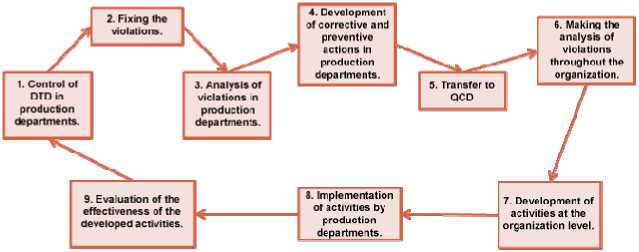
Fig. 1. Processing the data on violations of technological discipline
Рис. 1. Процесс обработки данных по нарушениям технологической дисциплины
_ 1000
_g 800
"I 6°°
5 400 о
I 200
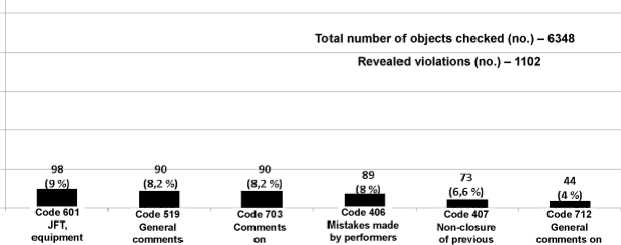
certification on DO and production in the design operations workplaces has expired TD culture of accompanying documents
Recurring violations, no. (%)
Fig. 2. Recurring violations of technological discipline in the production departments for the first half of 2017
Рис. 2. Повторяющиеся нарушения по технологической дисциплине по производственным подразделениям за I полугодие 2017 года
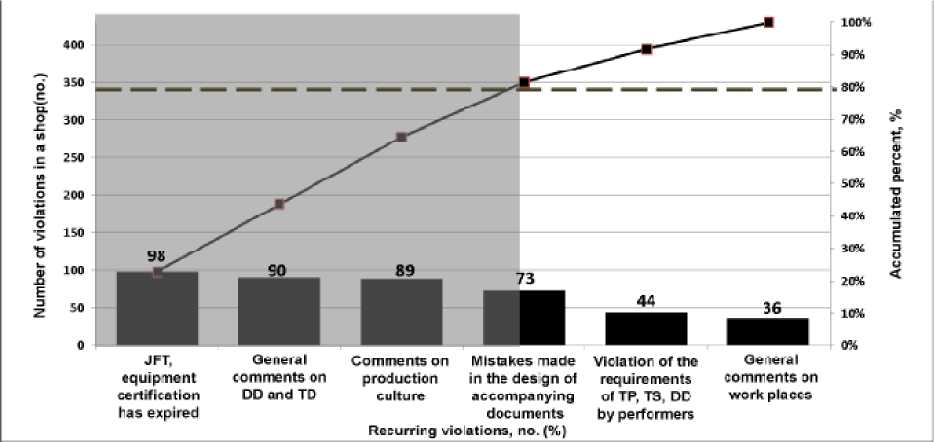
Fig. 3. Pareto diagram of recurring violations in the organization
Рис. 3. Диаграмма Парето повторяющихся нарушений по организации
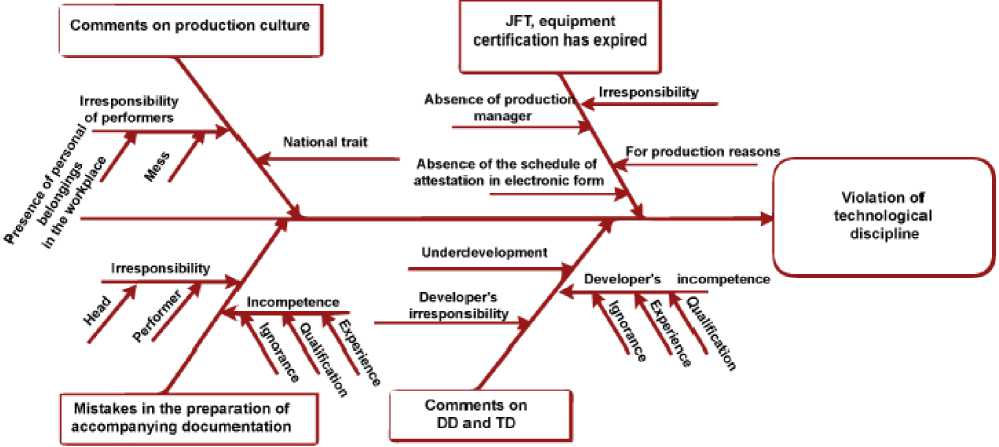
Fig. 4. Diagram of causes and results of recurring violations in the organization
Рис. 4. Диаграмма причин и результатов повторяющихся нарушений по организации
Table 2
Measures to prevent recurring violations of technological discipline
|
Measures to prevent recurring violations |
Responsible for implementation |
Supervisor |
Deadline |
|
1. Deliver required minimum of technical knowledge to technologists on the timely implementation of changes in AI in technological processes, as well as on additional monitoring of the state of DD and TD when issuing them from the archive |
Chief of Technological Bureau |
Chief of technical control bureau (hereinafter – TCB) |
15.09.2017 г. |
|
2. Deliver required minimum of technical knowledge to technologists to comply with the requirements of standards for the completion of technological passports and maintenance of technical processes |
Chief of Technological Bureau |
Chief of TCB |
15.09.2017 г. |
|
3. To develop the schedule of attestation of JFT and equipment in electronic form |
Responsible for preparation of production |
Chief of a workshop |
12.10.2017 г. |
End of table 2
|
Measures to prevent recurring violations |
Responsible for implementation |
Supervisor |
Deadline |
|
4. Issue an order to assign duties for compliance with the schedule of certification of equipment in the absence of the person responsible for the preparation of production and certification of JFT, equipment (vacation, business trip, sick leave) |
Chief of a workshop |
Chief of TCB |
15.09.2017 г. |
|
5. Deliver required minimum of technical knowledge to performers about the requirements of standards for the preparation of accompanying documentation |
Chief of TCB |
Chief of a workshop |
15.09.2017 г. |
|
6. Work through the entire range of JFT and include the missing positions in the certification schedule |
Responsible for preparation of production |
Chief of a workshop |
10.10.2017 г. |
|
7. During the shop “Hour of quality” to discuss with the chiefs of production sites the problem of the observance of order by the performers at their workplaces and the absence of dusting materials in the clean zones |
Chief of TCB |
Chief of a workshop |
05.09.2017 г. |
|
8. Deliver required minimum of technical knowledge to performers according to the requirements of the standard on culture of production |
Head of Production Section |
Chief of TCB |
05.09.2017 г. |
Conclusion. The analysis of data for the first quarter of 2017 after the approbation of the coding system showed an increase in the number of violations detected during internal inspections in departments (in the first half of 2016 the number of violations revealed was 13.8 % of violations from the number of objects, and in the first half of 2017 it was 19.6 %); in its turn, the number of violations revealed by external control (factory commissions, external audits) decreased in comparison with 2016 (from 20 to 17.6 %), which may indicate that the work on the development of corrective and preventive actions ongoing within departments has led to a reduction in the number of comments made by external audits.
One of the further strategic goals for the implementation of the coding system is the creation and implementation of an automated system that includes special software for the efficient analysis of the received data on violations of technological discipline and the timely development of corrective and preventive actions, both at the level of structural departments and at the level of the organization as a whole.
Список литературы Increasing the level of technological discipline by introducing the coding system using statistical methods in the analysis
- Взамен ОСТ 92-0200-83. Методические рекомендации. Система управления качеством труда. Основные положения: МДК 92-004-88. Изд. офиц. 85 с.
- Свиткин М. З., Мацута В. Д., Рахлин К. Н. Менеджмент качества и обеспечение качества продукции на основе международных стандартов ИСО. СПб.: Изд-во Санкт-Петерб. карт. фабрики, 1999. 403 с.
- Всеобщее управление качеством/О. П. Глуд-кин . М.: Лаборатория базовых знаний, 2001. 599 с.
- Кумэ Х. Статистические методы повышения качества. М.: Финансы и статистика, 1990. 304 с.
- Нив Г. Р. Пространство доктора Деминга: пер. с англ. Тольятти: Городской общественный фонд «Развитие через качество», 1998. Т. 1. 336 с.
- Кедрова С. Э. Инструменты качества. Ч. V. Контрольные листки//Методы менеджмента качества. 2000. № 5. С. 23-30.
- ГОСТ ISO 9001-2011. Система менеджмента качества. Требования. Изд. офиц. М.: Стандартин-форм, 2012.
- ГОСТ ISO 9000-2011. Система менеджмента качества. Основные положения и словарь. Изд. офиц. М.: Стандартинформ, 2012.
- ГОСТ Р ИСО 19011-2012. Руководящие указания по аудиту систем менеджмента. М.: Стандарт-информ, 2013.
- Кедрова С. Э. Инструменты качества. Ч. IV. Гистограммы//Методы менеджмента качества. 2000. № 3. С. 28-33.
- Шоттмиллер Дж. Статистическое управление процессами -эволюция в новое столетие//Методы менеджмента качества. 2005. № 5. С. 36-43.
- Статистическое управление технологическим процессом//Всё о качестве. Отечественные разработки. М.: НТК «Трек», 2001. Вып. 6. 60 с.
- Статистические методы управления процесса-ми (SPC). Руководство: пер. с англ. Н. Новгород: АО НИЦ КД: СМЦ «Приоритет», 1997. 170 с.
- Статистические методы в управлении качеством. Семь простых инструментов: учеб. пособие/С. В. Дранишников . Красноярск, 2014. 147 c.
- Разу М. Л. Применение диаграммы Парето на практике . URL: http://www. elitarium.ru/diagramma-pareto-princip-80-20-reshenie-mrtod-abc-analiz/.

